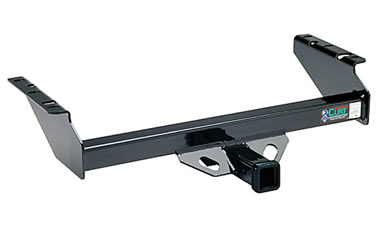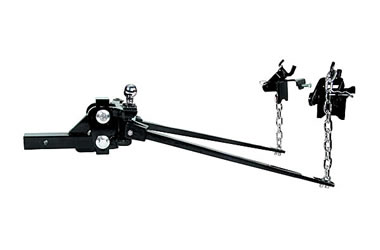What’s so tough about receiver hitches, anyway? Ya buy one, bolt it on the back of the truck, and start towing, right? Well, it’s a little more complicated than that. But thanks to the folks at Curt Manufacturing, we’re going to learn you about receiver hitches—what they are, how to choose one, and what all those hitch terms mean.
What is a Receiver Hitch?
Kind of a no-brainer… a receiver hitch is the actual bar of steel that attaches to your tow vehicle. Standard receiver hitches have an opening, or collar, for the hitch ball and mount (more on those in a minute). Quality receivers like Curt’s hitches are fully welded for strength and powdercoated to resist rust. Most hitches bolt to the tow vehicle using existing holes in the frame or subframe.
Receiver hitches are rated by class. Classes designate the amount of weight a hitch can safely handle (weight carrying capacity). That weight is determined by two factors. One is Gross Trailer Weight (GTW)—the total weight of a trailer and its cargo. The other is Tongue Weight (TW)—the downward force placed on the hitch ball by the trailer’s coupler. Tongue weight is usually 10 to 15 percent of GTW.
Here are the classes and load ratings for standard hitches:
Class 1: 1,000 to 2,500 lbs. GTW, 200 lbs. TW
Class 2: 3,500 lbs. GTW, 300 lbs. TW
Class 2.5: 4,000 lbs. GTW, 400 lbs. TW
Class 3: 6,000 lbs. GTW, 350-600 lbs. TW
Class 4: 8,000 lbs. GTW, 800 lbs. TW
Class 5: 10,000 lbs. GTW, 1,000 lbs. TW
You can increase the load capacity of Class 3 and higher hitches with a weight distribution kit. The kit includes two “spring bars” and mounts that connect to the trailer to help balance the load evenly between the trailer and the tow vehicle. That improves braking and steering and helps keep the trailer level.
Hitch Balls and Mounts
We mentioned hitch balls and mounts earlier. The hitch ball is the physical connection between the tow vehicle and the trailer. It threads into the ball mount and is secured with a nut. Hitch balls are available in several diameters to fit a variety of ball sockets on trailer couplers.
Ball mounts have a square tube shank that fits in the receiver hitch’s collar and is secured with a steel pin. They are available with different ball mounting pad heights. It’s important to get the proper height mount to keep the trailer and tow vehicle level with each other.
Hitch balls and mounts are rated by load capacity. Make sure you use components that are rated at or more than the load you are towing. Curt has a wide variety of balls and mounts for virtually any towing scenario.
Safety Chains
Two items that must be considered are safety chains and trailer tires. The chains are used to keep the trailer secured to the tow vehicle if the coupler separates from the hitch. Two chains are uses, which should cross each other under the trailer tongue so it doesn’t hit the ground. The chains should have enough slack so the tow vehicle can make turns. The chains must be attached to the receiver hitch or vehicle frame, never the bumper.
Chains are also rated by capacity, in this case the minimum breaking force by trailer/hitch class:
Class 1 Trailer: 2,000 lbs. breaking force
Class 2 Trailer: 3,500 lbs. breaking force
Class 3 Trailer: 5,000 lbs. breaking force
Class 4 Trailer: must have a minimum breaking force equal to or exceeding the Gross Vehicle Weight (GVW) of the trailer
Other Considerations
Here are additional items to consider when selecting a hitch and towing components:
- Consult your vehicle’s operating manual for the recommended towing capacities. Curt’s chart shows hitch class recommendations for various vehicle types.
- Don’t skimp on tires for your tow vehicle or trailer. They need to be rated for the load you plan to tow—loading a trailer beyond the tire rating could cause tire failure. Make sure tires are properly inflated to minimize trailer sway.
- Make sure the electrical systems on your trailer and tow vehicle are functioning properly. That includes brakes, lights, and connectors.
- If your trailer has brakes, it is strongly recommended you use an electronic brake controller to make brake application as smooth as possible. Curt has time-based and inertia-based brake controllers for trailers with up to three axles.
- Consider using a sway control if you tow a large trailer. This device controls the sideways movement of the trailer in strong winds or on rough roads. A sway control is recommended for Class 3 and stronger hitches.
- Make sure at least 60 percent of the trailer cargo is loaded from the front axle forward, and that the heaviest items are loaded first. This helps balance the load between the trailer and the tow vehicle.
We hope you learned something from our little receiver hitch primer. If you need more information on choosing the right hitch and towing goodies for your trailer, Curt’s website has scads of product listings and more useful tips. Class dismissed!











[…] your race car running strong once you’re at the track. We also spent an earlier post covering how to choose a trailer hitch for your transport vehicle, so now it’s only fitting that we help you outfit your race […]
I appreciate all of the information that you shared about choosing the right hitch. The point that you shared about consulting my operating manual for recommended towing capacities will surely come in handy. I will be sure to utilize these tips to ensure that I make the right hitch decision for my vehicle.
What size ball do i need for a class one popup trailer?